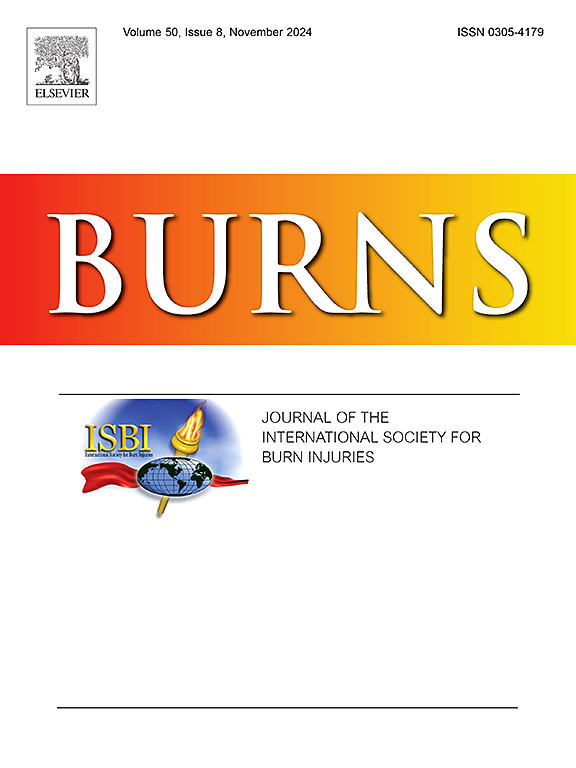小儿部分厚度烧伤的敷料是否重要:系统回顾和荟萃分析
IF 3.2
3区 医学
Q2 CRITICAL CARE MEDICINE
引用次数: 0
摘要
浅表部分厚度烧伤通常接受非手术治疗,而深度部分厚度烧伤,容易形成肥厚疤痕,通常通过清创和自体厚皮移植来处理。各种治疗方法已开发,以防止伤口感染和促进伤口愈合的儿童部分厚度烧伤。然而,外科医生选择的敷料会受到各种因素的影响。值得注意的是,在所有烧伤中心没有标准化的方法,导致护理实践的变化。为了优化儿科患者的护理,根据PRISMA指南进行了系统的回顾,回顾了儿童部分厚度烧伤的现有治疗方案。研究的结果包括伤口愈合时间、换药时间、住院时间、伤口感染、治疗后是否需要移植和增生性瘢痕形成。共纳入68项研究,8199例患者。患者平均年龄3.1岁,烧伤平均体表面积15.6% %。治疗组包括外用药物、绷带、皮肤类似物或未分类。考虑到本文献系统综述中评估的所有治疗结果,非银敷料和皮肤类似物在伤口愈合时间、住院时间、增生性疤痕、疼痛管理和成本节约方面可能比局部药物有一些好处。换药、伤口感染和移植需求在不同治疗之间没有显著变化。本文章由计算机程序翻译,如有差异,请以英文原文为准。
Does the dressing matter in pediatric partial-thickness burns: a systematic review and meta-analysis
Superficial partial thickness burns typically receive nonoperative treatment, whereas deep partial thickness burns, which are prone to hypertrophic scarring, are usually managed through debridement followed by autologous split-thickness skin grafting. Various therapies have been developed to prevent wound infection and to enhance wound healing in pediatric partial-thickness burns. However, the choice of dressing by the surgeon can be influenced by various factors. It is worth noting that there is no standardized approach across all burn centers, leading to variations in care practices. To optimize pediatric patient care, a systematic review was conducted following PRISMA guidelines to review existing treatment options for partial thickness burns in children. Outcomes of interest were wound healing time, dressing changes, length of hospital stay, wound infections, need for grafting despite treatment, and hypertrophic scarring. A total of 68 studies with 8199 patients were included. The mean age of the included patients was 3.1 years, and the mean total body surface area of the burns was 15.6 %. Treatment groups included topical agents, bandages, skin analogues, or unclassified. Considering all treatment outcomes evaluated in this systematic review of the literature, non-silver dressings and skin analogues may have some benefit over topical agents in terms of wound healing time, length of hospital stay, hypertrophic scarring, pain management, and cost saving. Dressing changes, wound infections, and need for grafting did not significantly change between various treatments.
求助全文
通过发布文献求助,成功后即可免费获取论文全文。
去求助
来源期刊

Burns
医学-皮肤病学
CiteScore
4.50
自引率
18.50%
发文量
304
审稿时长
72 days
期刊介绍:
Burns aims to foster the exchange of information among all engaged in preventing and treating the effects of burns. The journal focuses on clinical, scientific and social aspects of these injuries and covers the prevention of the injury, the epidemiology of such injuries and all aspects of treatment including development of new techniques and technologies and verification of existing ones. Regular features include clinical and scientific papers, state of the art reviews and descriptions of burn-care in practice.
Topics covered by Burns include: the effects of smoke on man and animals, their tissues and cells; the responses to and treatment of patients and animals with chemical injuries to the skin; the biological and clinical effects of cold injuries; surgical techniques which are, or may be relevant to the treatment of burned patients during the acute or reconstructive phase following injury; well controlled laboratory studies of the effectiveness of anti-microbial agents on infection and new materials on scarring and healing; inflammatory responses to injury, effectiveness of related agents and other compounds used to modify the physiological and cellular responses to the injury; experimental studies of burns and the outcome of burn wound healing; regenerative medicine concerning the skin.
 求助内容:
求助内容: 应助结果提醒方式:
应助结果提醒方式:


